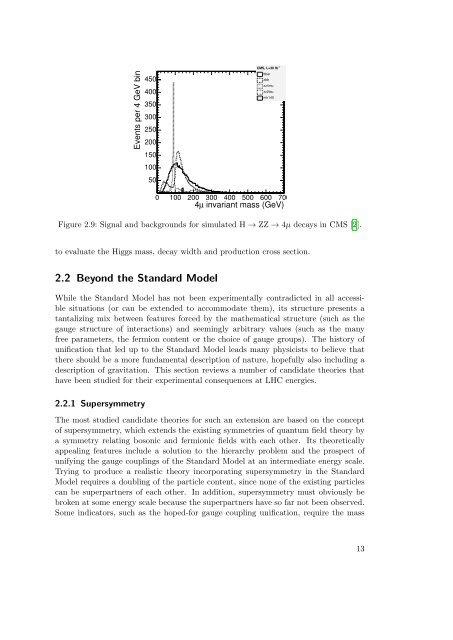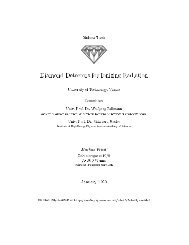You also want an ePaper? Increase the reach of your titles
YUMPU automatically turns print PDFs into web optimized ePapers that Google loves.
Events per 4 GeV bin45040035030025020015010050-1CMS, L=30 fbttbarzbbzz4muzz2taumh1400 100 200 300 400 500 600 7004µ invariant mass (GeV)Figure 2.9: Signal and backgrounds for simulated H → ZZ → 4µ decays in CMS [2].to evaluate the Higgs mass, decay width and production cross section.2.2 Beyond the Standard ModelWhile the Standard Model has not been experimentally contradicted in all accessiblesituations (or can be extended to accommodate them), its structure presents atantalizing mix between features forced by the mathematical structure (such as thegauge structure of interactions) and seemingly arbitrary values (such as the manyfree parameters, the fermion content or the choice of gauge groups). The history ofunification that led up to the Standard Model leads many physicists to believe thatthere should be a more fundamental description of nature, hopefully also including adescription of gravitation. This section reviews a number of candidate theories thathave been studied for their experimental consequences at LHC energies.2.2.1 SupersymmetryThe most studied candidate theories for such an extension are based on the conceptof supersymmetry, which extends the existing symmetries of quantum field theory bya symmetry relating bosonic and fermionic fields with each other. Its theoreticallyappealing features include a solution to the hierarchy problem and the prospect ofunifying the gauge couplings of the Standard Model at an intermediate energy scale.Trying to produce a realistic theory incorporating supersymmetry in the StandardModel requires a doubling of the particle content, since none of the existing particlescan be superpartners of each other. In addition, supersymmetry must obviously bebroken at some energy scale because the superpartners have so far not been observed.Some indicators, such as the hoped-for gauge coupling unification, require the mass13












